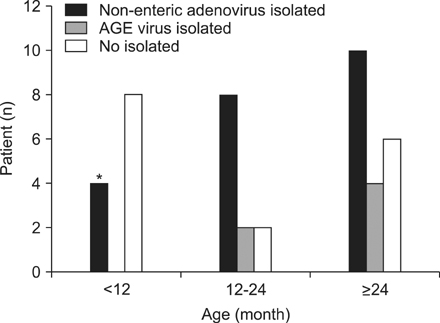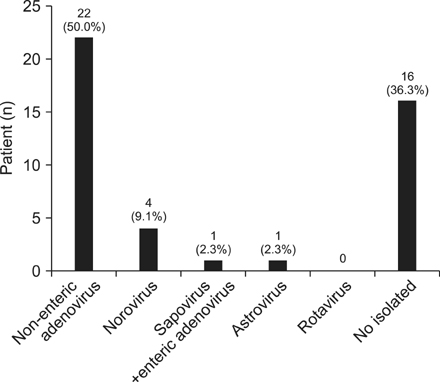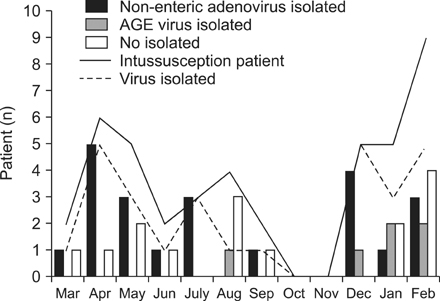Pediatr Gastroenterol Hepatol Nutr.
2013 Sep;16(3):162-170. 10.5223/pghn.2013.16.3.162.
Clinical Features and Role of Viral Isolates from Stool Samples of Intussuception in Children
- Affiliations
-
- 1Department of Pediatrics, Chungnam National University School of Medicine, Daejeon, Korea. pedkim@cnuh.co.kr
- 2Department of Laboratory Medicine, Chungnam National University School of Medicine, Daejeon, Korea.
- KMID: 2051329
- DOI: http://doi.org/10.5223/pghn.2013.16.3.162
Abstract
- PURPOSE
To detect major acute gastroenteritis virus (rotavirus, norovirus, astrovirus, and enteric adenovirus) and non-enteric type of adenovirus (AdV) in the stools of intussusception patients and to investigate the clinical role of detected viruses.
METHODS
From March 2012 to February 2013, major acute gastroenteritis virus and non-enteric type of AdV were isolated from stool samples that collected from 44 patients treated for intussusception in Chungnam National University Hospital. Patients were divided according to age and isolated virus.
RESULTS
Virus was detected in 28 (63%) stool specimens. The virus detection rate was significantly lower in patients aged under 12 months (p = 0.04). Twenty-two patients (78.6%) had non-enteric adenovirus, 4 (14.3%) had norovirus, 1 (3.6%) had sapovirus, and 1 (3.6%) had astrovirus. AdV subgroup C (AdV 1, 2, 5, and 6) comprised the majority with 20 cases (90.9%). A monthly increment-and-decrement pattern of intussusception was similar to that of viral detection in the stool samples. Enema reductions were successful in 39 patients and surgical manual reductions were performed in 5 patients. Virus was detected in 24 patients (61.5%) of enema reduction group and 4 patients (80.0%) of surgical manual reduction group. All of the detected viruses were non-enteric adenovirus subgroup C (AdV 1, 5, and 6) in surgical reduction patients.
CONCLUSIONS
The virus detection rate was high in the stools of intussusception patients. The pattern of seasonal intussusception occurrence rate was parallel with seasonal these viral detection rate in the stool samples. These findings suggest that viral infection plays an important role in the development of intussusception and further research is warranted.
MeSH Terms
Figure
Cited by 1 articles
-
Identifying Predictive Factors for the Recurrence of Pediatric Intussusception
Dong Hyun Lee, Se Jin Kim, Hee Jung Lee, Hyo-Jeong Jang
Pediatr Gastroenterol Hepatol Nutr. 2019;22(2):142-151. doi: 10.5223/pghn.2019.22.2.142.
Reference
-
1. Fischer TK, Bihrmann K, Perch M, Koch A, Wohlfahrt J, Kåre M, et al. Intussusception in early childhood: a cohort study of 1.7 million children. Pediatrics. 2004; 114:782–785.
Article2. Kombo LA, Gerber MA, Pickering LK, Atreya CD, Breiman RF. Intussusception, infection, and immunization: summary of a workshop on rotavirus. Pediatrics. 2001; 108:E37.3. Murphy TV, Gargiullo PM, Massoudi MS, Nelson DB, Jumaan AO, Okoro CA, et al. Intussusception among infants given an oral rotavirus vaccine. N Engl J Med. 2001; 344:564–572.
Article4. Zanardi LR, Haber P, Mootrey GT, Niu MT, Wharton M. Intussusception among recipients of rotavirus vaccine: reports to the vaccine adverse event reporting system. Pediatrics. 2001; 107:E97.
Article5. Bines JE, Liem NT, Justice FA, Son TN, Kirkwood CD, De CM, et al. Risk factors for intussusception in infants in Vietnam and Australia: adenovirus implicated, but not rotavirus. J Pediatr. 2006; 149:452–460.
Article6. Okimoto S, Hyodo S, Yamamoto M, Nakamura K, Kobayashi M. Association of viral isolates from stool samples with intussusception in children. Int J Infect Dis. 2011; 15:e641–e645.
Article7. Korea Centers for Disease Control & Prevention. Influenza and respiratory virus report No. 195-247 [Internet]. Osong: Korea Centers for Disease Control & Prevention;2012~2013. cited 2013 Sep 1. Available from: http://www.cdc.go.kr/CDC/info/CdcKrInfo0502.jsp?menuIds=HOME001-MNU0003-MNU0048-MNU0050.8. Lappalainen S, Ylitalo S, Arola A, Halkosalo A, Räsänen S, Vesikari T. Simultaneous presence of human herpesvirus 6 and adenovirus infections in intestinal intussusception of young children. Acta Paediatr. 2012; 101:663–670.
Article9. Jakab F, Péterfai J, Verebély T, Meleg E, Bányai K, Mitchell DK, et al. Human astrovirus infection associated with childhood intussusception. Pediatr Int. 2007; 49:103–105.
Article10. Velázquez FR, Luna G, Cedillo R, Torres J, Muñoz O. Natural rotavirus infection is not associated to intussusception in Mexican children. Pediatr Infect Dis J. 2004; 23:10 Suppl. S173–S178.
Article11. El-hodhod MA, Nassar MF, Ezz ES, Ahmed EF. Rotavirus fecal antigen retrieval in infantile intussusception. Eur J Clin Microbiol Infect Dis. 2008; 27:879–881.
Article12. Peter G, Myers MG. National Vaccine Advisory Committee. National Vaccine Program Office. Intussusception, rotavirus, and oral vaccines: summary of a workshop. Pediatrics. 2002; 110:e67.
Article13. Kaemmerer E, Tischendorf JJ, Steinau G, Wagner N, Gassler N. Ileocecal intussusception with histomorphological features of inflammatory neuropathy in adenovirus infection. Gastroenterol Res Pract. 2009; 2009:579501.
Article14. Hsu HY, Kao CL, Huang LM, Ni YH, Lai HS, Lin FY, et al. Viral etiology of intussusception in Taiwanese childhood. Pediatr Infect Dis J. 1998; 17:893–898.
Article15. Selvaraj G, Kirkwood C, Bines J, Buttery J. Molecular epidemiology of adenovirus isolates from patients diagnosed with intussusception in Melbourne, Australia. J Clin Microbiol. 2006; 44:3371–3373.
Article16. Park BC, Kim SY, Jung SJ. A comparative analysis of clinical features and treatment outcomes of intussusception according to age distribution. Korean J Pediatr Gastroenterol Nutr. 2005; 8:150–156.
Article
- Full Text Links
- Actions
-
Cited
- CITED
-
- Close
- Share
- Similar articles
-
- Detection of Viral Antigens in Stool Using EIA in Hospitalized Children and Clinical Implication
- Adenovirus types in peaiatric gastroenteritis in seoul
- Characteristics of Klebsiella pneumoniae Isolates from Stool Samples of Patients with Liver Abscess Caused by Hypervirulent K. pneumoniae
- Utility of 293 Cells in Culture of Enteroviruses
- Isolation of Causative Viruses from Patients with Aseptic Meningitis in Gwangju Area




